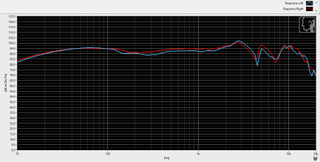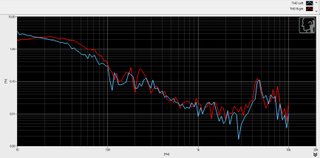How we're testing over 50 headsets and headphones
How to read the charts
Reading output charts is relatively easy, and gives a good indication of how a pair of headphones or a gaming headset will sound. The HATS system can measure microphones too, and the same data applies.
FREQUENCY RESPONSE

Frequency response shows the response of the headphones across the entire audible frequency spectrum. As you can see, I've set the test sweep to occur between 10Hz and 20kHz, but tests are usually done between 20Hz and 20kHz.
From the example readout, we're able to deduce that the headphone in question has excellent bass extension with some trail off starting at 30Hz. The bass frequencies are stronger than the mid ranges, and climb at about 2kHz. Between 2kHz and 6kHz is essentially where the manufacturer intentionally tunes the headphones, but after about 8kHz the spikes and dips you see are caused by the actual structure of the headphone itself. At 10kHz, the headphone's response begins a curve downward.
Ideally, you'll want a pair of headphones that has a completely flat frequency response across the entire spectrum, but this is impossible. Physics, driver dynamics, and resonance will impact frequency response. The intention of the manufacturer also plays a big part. If you measure Beats, for example, you'll expect a bump in the bass frequencies.
A good pair of headphones will have bass linearity between 20Hz to 100Hz with +/- 5dB of variance. Treble frequencies between 1kHz and 10kHz should be, on average, flat, depending on the design. Upper treble is much more difficult to control, but good headphones will not exhibit crazy spikes and valleys.
When there are odd bumps in the frequency range between 100Hz and 3kHz, you've got problems. The above headphones show a smooth response in those ranges, indicating good engineering to mitigate resonance.
TOTAL HARMONIC DISTORTION

Total harmonic distortion (THD) measures audible distortion emitted by the drivers in the headphones. Good headphones should not exhibit THD beyond two percent at 98dB. You'd be surprised that even some flagship hi-fi headphones will have THD that reaches 10 percent, which is unacceptable.
PC Gamer Newsletter
Sign up to get the best content of the week, and great gaming deals, as picked by the editors.
Expect good headphones to maintain less than one percent THD in almost the entire frequency spectrum. Bass frequencies are more difficult to control. Headphones that emphasize a lot of bass will produce huge THD below 100Hz. In other words, the bass you hear may sound punchy, but it might also be bad quality bass. You want something that delivers clean and tight bass response, that doesn't cause other frequencies to be smothered.
You may have noticed that the THD test isn't THD+N (noise). This is because, well, the world is full of noise. There's no sense measuring that, too. The THD being measured is what the headphone produces, only.
LEFT/RIGHT TRACKING

No two drivers are exactly alike. Manufacturers do their best to make sure both the left and right drivers are matched as closely as possible, but sometimes this isn't the case. Expect left/right tracking to be severe if the headphone in question is of poor quality.
IMPEDANCE

The impedance plot allows us to see whether a voice coil is aligned to its magnet. If alignment is poor, the plot will have spikes throughout the frequency range. Magnets that are properly aligned will generate a smooth line like the one you see above. When the voice-coil and magnets are not aligned, the headphone will actually send current fluctuations back, and we can measure that with impedance changes.
This plot mainly only applies to dynamic voice-coil drivers and does not impact headphones that are planar-magnetic or electro-static because they don't use voice-coils that need alignment.
Most Popular


